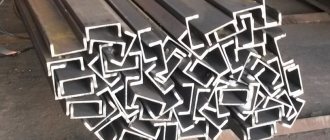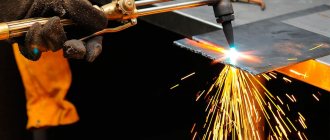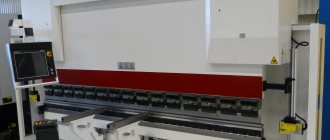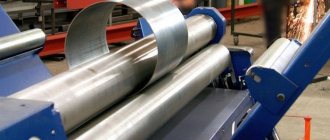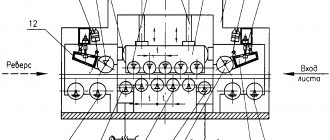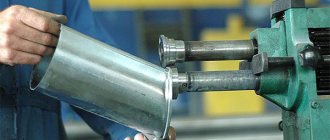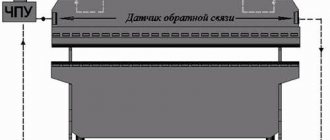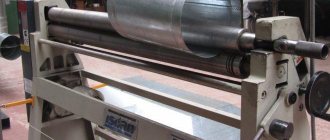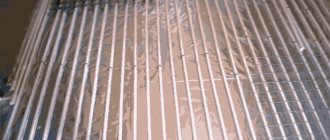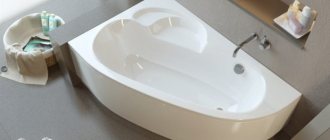Characteristics of sheet material
Hot-rolled steel sheets are heated and subjected to deformation in rolling mills and presses. To avoid defects in the form of different thicknesses, the material is processed by cold rolling, which increases its useful characteristics.
Depending on the production method, a distinction is made between hot-rolled (HK) sheets and cold-rolled (CC) sheets. Proportional metal plates in thickness range from 0.36 to 3.98 mm (dimensions of thin-sheet steel) and from 4 to 160 mm (dimensions of thick-sheet material). There are rolled products with cut and uncut side edges.
Plate sizes
The material is widely used in industry, so it is necessary to produce many standard sizes of products. The average value of a sheet with a width of 1.25 m and a length of 2.5 m is taken as the standard. The dimensional parameters for hot-rolled and cold-drawn products are different. The thickness of the metal sheet varies depending on the purpose of application and production technology. Depending on the thickness, the weight of the product changes. Main dimensional parameters:
- With a sheet thickness of 3 mm, a width of 1.5 m and a length of 6.0 m, the plate weighs about 72 kg. The maximum thickness of cold-drawn steel is 0.4 mm.
- The standard common size of a cold sheet is 1.0 x 2.0 meters, while the size of the strips is 1.2 x 2.5 m; galvanization has slightly different dimensions, despite the standardization of all materials according to GOST 19904–1974.
- Galvanized standard strips are 0.55 mm thick; products are available in thicknesses of 1.4 mm, 1.2 mm, 1.0 mm, 0.7 mm, 0.5 mm, 0.45 mm, and 0.4 mm. The width of galvanization is usually 1.25 m with a length of 2.5 m.
- Hot-rolled steel plates are produced in sizes of 1.25 x 2.5 m, while the thickness ranges from 0.5-3 mm, and the sheet thickness is added at intervals of 0.5 mm. Thick-walled plates have large dimensions, they are produced in 1.5 x 6.0 m and 2.0 x 6.0 m, 2 mm sheet metal is widely used. Sheet weight ranges from 13.5 kg to 64 kg with a minimum and maximum strip thickness.
Steel sheet 3 mm
Steel sheet 3 mm - dimensions, weight 1 m2, price per sheet, ton
| GOST | Hot rolled (GOST 19903-74) | Cold rolled (GOST 19904-90) | ||
| Standard sizes (cutting) | 3x1250x2500 | 3x1500x6000 | 3x1250x2500 | |
| Specifications | Rolled thin sheet GOST 16523-97 carbon steel | |||
| Weight 1 m2 | 24.26 kg | 24.26 kg | ||
| Weight of 1 sheet | 75.8 kg | 219 kg | 75.80 kg | |
| Number of sheets per ton | 13.19 pcs. | 4.58 pcs. | 13.19 pcs. | |
| Price per ton (as of December 2019) | 42690 rub. | 43790 rub. | 49890 rub. | |
| Price per m2 (Price per ton x Weight 1 m2 / 1000) | 1036 rub. | 1062 rub. | 1210 rub. | |
| Price per sheet (Price per ton x Weight of 1 sheet / 1000) | 3236 rub. | 9590 rub. | 3782 rub. | |
| Current price for today | price for 3 mm hot rolled sheet | price for 3 mm cold rolled sheet | ||
Difference between cold-drawn and hot-rolled methods
Manufacturing involves passing the workpiece through specially prepared rollers. This reduces the thickness and adjusts it to the required length and width.
As a result of using different production technologies, wafers are obtained whose properties differ from each other. The choice of method for producing steel strips depends on the intended purpose for further use.
Deformation at high temperatures is carried out under conditions exceeding the recrystallization rates of the material. The temperature should rise to 60% of the metal melting indicators. The initial workpiece is called a slab. The ease of deformation at high temperatures is explained by the fact that the strength of steel decreases. This circumstance makes it possible to reduce the force aimed at giving the workpiece the desired shape.
Cold rolled products are characterized by deformation at temperatures ranging from +20...+25˚С (room temperature). The initial workpiece is represented by a hot-rolled plate. Before forming, the material is cleaned of scale using sandblasting, shot blasting units, or using acids and their compositions.
Deformation at low temperatures, below 30% of the melting point, causes the formation of strain hardening (hardening) in the sheet body. This increases the strength of the plates and reduces ductility; for deformation, the force load must be increased. To partially recrystallize the structure, reduce hardness and make the material plastic, tempering is done in the form of additional heat treatment.
Hot deformation
Steel contains different elements, so when heated it is impossible to ensure a uniform increase in temperature. Rolling of a well-heated section proceeds faster than a cold one; the process is carried out with different parameters, which leads to the appearance of defects. The difference between cold and hot produced sheets can be seen with the naked eye.
The method makes it possible to obtain products in a sufficient range of thickness to satisfy consumer needs. Such sheets are used for coatings in construction. At the same time, a lot of money is not spent on the production of plates. The material has increased corrosion resistance compared to cold produced sheets.
The disadvantages of production include the following points;
- there are surface imperfections, there are areas of scale that need to be removed;
- it is impossible to obtain very thin plates;
- dimensions have low accuracy;
- welding negatively affects the quality of the product.
Cold rolled products
The method makes it possible to obtain very thin flat sheets of several microns, and the geometric parameters of the product are highly accurate. The result is a high-quality and smooth surface; such material can be used for the production of objects and parts in cases where the aesthetic side of the product is important. In construction, cold-drawn metals are used for cladding walls, floors and other finishes. The popular use for welding is due to the fact that the material does not conduct with this method of joining.
The disadvantages of cold-rolled products include the following characteristics:
- poor resistance to corrosion in the open air without an anti-corrosion protective layer;
- sheets have reduced ductility due to increased hardness;
- the high cost of production affects the price of the material, this is explained by the use of many complex units and the use of large amounts of energy.
.. | Sheet 2 mm hot rolled
Sheet 2 mm hot rolled
2 mm metal sheet is one of the most popular rolled products in use. It is convenient to use for the production of thin-walled profile or electric-welded pipes, channels, angles, and PVL sheets. It is used in construction, shipbuilding and mechanical engineering, the oil and gas industry, in heat and power engineering, for structural elements, various mechanisms, in the production of various household and agricultural equipment, instruments, decorative panels, in interior design, building cladding, and on personal plots. Corrugated sheet metal is made from thin sheet steel in rolls - for roofs, fences, walls and partitions. After rolling, the corrugated sheet is galvanized and painted for anti-corrosion properties. Sheet 09G2S is used at extremely low temperatures or at elevated temperatures, for parts exposed to pressure.
Sheet gk st3 2mm is valued for its low cost, smoothness, ductility, malleability and flexibility of the metal, the ability to make other types of rolled metal and various products from it, light weight and strength. Hot rolled sheets can be welded. Its light weight allows it to be used to make hoods, air ducts, and any lightweight structures. The disadvantage is the need for periodic painting and low fire resistance.
2 mm hot rolled sheet metal is produced as follows:
2 mm hot-rolled steel sheets are produced on continuous lines, which, when heated at temperatures up to 760 degrees Celsius and high pressure, pass through numerous rotating shafts, become wider and thinner, and then cold-rolled to impart certain properties, smoothness and improve the quality of the metal . A heated sheet has scale and unevenness, but rolling initially cold metal requires more powerful machines. In addition, the cold-rolled sheet must be additionally fired and heat treated to relieve the internal stress of the steel. Therefore, hot-rolled sheet 2 mm is cheaper than its cold-rolled counterpart, and if there are no special requirements for the quality of the sheet, then hot-rolled sheet is used.
Sheet St3 2 mm is supplied by Novolipetsk Iron and Steel Works JSC, Severstal JSC, Zaporozhye Metallurgical Works JSC Zaporizhstal, Magnitogorsk Iron and Steel Works JSC, Chelyabinsk Iron and Steel Works JSC and others.
Steel sheet 2 mm is classified as thin sheet and is produced in accordance with GOST 19903 in terms of assortment. Such hot-rolled metal sheet 2 mm is produced in accordance with GOST 16523 and GOST 17066. Standard 16523 applies to all rolled carbon steel thin sheets for general purposes. The steel used is high-quality or ordinary quality. These can be brands 08ps, 10ps, St1 - 3ps. GOST 17066 requires high-strength steel; our company sells 2 mm sheets of steel grade 09G2S.
In terms of rolling accuracy, a 2 mm iron sheet can be of increased or normal accuracy. The edge of such a sheet can be trimmed or unedged. According to the flatness, the sheet is distinguished between especially high, high, improved and normal flatness. Sheet 2 mm hot-smoked can be deep and have normal stretchability. Its surface finish can be either high or normal.
Sheet size 2 mm thick
JSC Metallotorg supplies 2 mm hot-rolled sheets, cut 1250 mm * 2500 mm and 1000 mm * 2100-2300 mm. With a sheet width of 1250 mm, the weight of a 2 mm sheet will be 19.63 kg per 1 meter.
Buy hot rolled sheet
You can buy a sheet of 2 mm st3 or 09G2S from our company from any warehouse in Russia. We can move the missing tonnage to the branch closest to you. Our specialists will help you quickly and efficiently calculate the required amount of material, issue an invoice and deliver the metal as quickly as possible. A 2 mm thick sheet easily fits into both an open gazelle and a valdai; it is not necessary to order a long one, which will significantly affect your budget. We also provide the service of cutting sheets of 2 mm in size. This thin sheet is packed in the warehouse with tape for safe transportation. Iron sheet 2 mm, the price per sheet will be determined by our managers, and the price per ton is indicated in the price lists of our organization.
Areas of use
The different uses of materials in industry are due to the variety of properties. Products obtained by hot and cold methods have different properties. Hot rolled metal plates are most often used:
- in the construction of ships, airliners, cars, the material is used in structures where the joints are connected using hardware and without welding;
- in the construction field, metal is used in the form of load-bearing frame elements and in the manufacture of internal structure elements with subsequent finishing;
- for the manufacture of pipes by soldering;
Cold drawn sheet is used in the following cases:
- in the production of corrugated sheets and for the production of smooth galvanized sheets;
- in automobile production;
- for the production of thin sheet metal with a tin covering layer, used in the production of canning containers;
- in the manufacture of decapir (annealed plates) used in the production of enamelware;
- a high-quality smooth surface requires its painting with powder compositions, nickel plating and chrome plating;
- for cold stamping.
Visible sheet defects
During the manufacturing process, surface defects or dimensional deviations occur. They are classified into certain categories. The appearance of deviations and defects of a certain type is characterized by improper organization and equipment of the production process.
Scratches, irregularities, oblique cuts
Such violations are characterized by the appearance of mechanical damage to the strip in the form of depressions across and along the rolling direction. Deviations in dimensions in length and width from the standard specified parameters are diagnosed by an amount exceeding the permissible values. On the surface, protrusions of material are formed along the width and length at the edges of strips or sheets, having a right angle with the surface.
The reasons causing such deviations from the norm may be:
- metal elements of equipment protruding beyond normal limits, sometimes defects are caused by stuck pieces of metal;
- poor adjustment of flying or disc shears, or their weak fastening during installation;
- untimely sharpening of knives;
- crescent shape of the strip itself;
- improper organization of feeding of rolled strip into the cross-cutting machine;
- unprofessional setting of pulling and feeding rollers.
Fat, wave, scatter and crescent
A slight waviness of the rolling strip appears along both edges or only on one side. On the surface of the plate, prints of various sizes and shapes are visible in the form of elongated spots or stripes. Smoothness is disrupted by the appearance of sharp holes, grooves and imprints of mechanical origin.
There are kinks and bends on the plate in different directions, corners and edges are often bent. When packing sheets into bundles, a shift in the size of the sheets along the width or length of the package relative to each other appears greater than the permissible norm. Damage of one kind or another is noted on the side edges, the corners may be curled, and the strip itself has a crescent shape.
Defects are caused by the following reasons:
- misalignment of feed and receiving rollers or rollers;
- poor adjustment of the correct rollers and disc knives;
- waste and other metal parts stick to the rollers and straightening rollers;
- the strip is not protected when cutting from small metal shavings and parts;
- jamming of rolled material in packaging devices;
- improper threading of the strip for advancement with pulling and straightening rollers, sagging and pressure on the roll screws from the outside;
- careless adjustment of wiring fittings, malfunction of the conveyor belt, incorrect height adjustment of the pocket and lifting table;
- installation of stops in baling units (in their pockets) in violation of standards;
- Incorrect adjustment of scissors and loosening of vertical rollers and wires.
Protective films against corrosion
This concept refers to coating the surface of a metal with a zinc-based layer to improve protection against damage and corrosion. The principle of protection is based on certain properties of non-ferrous metals. Aluminum, zinc, and tin oxidize in the open air, resulting in the formation of a film. It does not allow oxygen into the metal and inhibits further oxidation.
In hardware the process occurs differently. As a result of oxidation, compounds appear, hydroxides, characterized by an increase in volume relative to the original metal. Because of this, the film becomes loose and quickly collapses. It does not protect the body of the intact metal from oxygen, and oxidation affects the internal layers.
Iron does not tolerate air well, so a rusty layer forms on the surface. To protect against this, a protective film made of non-ferrous metals, such as tin, is used, which protects the iron from destructive corrosion.
The principle of operation of tin and zinc is approximately the same as long as the protective film is not damaged until the iron is exposed. If the iron is coated with zinc, then together they create a galvanic couple. When reacting, iron is more passive compared to zinc, which oxidizes first, and the iron is protected because of this.
Tin also forms a pair with iron, but is not an active substance, therefore, if the tin layer is damaged, iron is the first to oxidize, which provokes its further destruction and corrosion at the site where the integrity is damaged.
Features of dynamic steel
Strips of dynamic cold-drawn steel differ from strips obtained by the hot method because they are thicker, have a better surface, and are free of scale. The high characteristics of dynamite steel are used in the manufacture of electrical machines. This gives a high fill factor, saves energy, and increases power with older dimensions.
Supplying cold rolled steel in strips offers advantages in cutting and receiving due to less waste. Due to high-quality processing, dynamic steel has more stable properties.
Where to buy sheet metal 2.0×1250×2500
Our metal warehouse offers rolled metal sheets, steel sheet 2 mm ×1250×2500 at retail and wholesale. The terms of sale are not limited; you can purchase any product from one unit. If necessary, we provide additional services for sheet cutting, loading and delivery to the destination.
Wholesalers receive additional benefits in terms of the cost of rolled metal.
You can study the range of products, their cost and purchasing opportunities on the metal rolling website. If you need to ask a question, use the feedback form or contact information provided on the site. Our managers are always in touch and will give detailed advice on the purchase of sheet metal.
